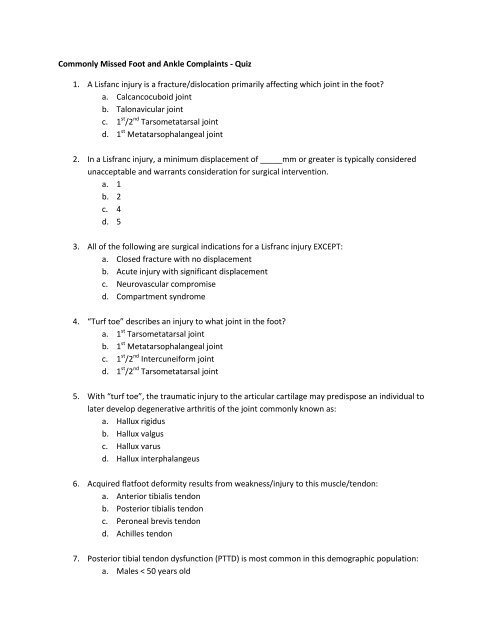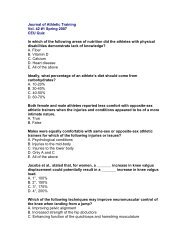Commonly Missed Foot and Ankle Complaints - Quiz 1. A Lisfanc ...
Commonly Missed Foot and Ankle Complaints - Quiz 1. A Lisfanc ...
Commonly Missed Foot and Ankle Complaints - Quiz 1. A Lisfanc ...
Create successful ePaper yourself
Turn your PDF publications into a flip-book with our unique Google optimized e-Paper software.
<strong>Commonly</strong> <strong>Missed</strong> <strong>Foot</strong> <strong>and</strong> <strong>Ankle</strong> <strong>Complaints</strong> - <strong>Quiz</strong><strong>1.</strong> A <strong>Lisfanc</strong> injury is a fracture/dislocation primarily affecting which joint in the foot?a. Calcancocuboid jointb. Talonavicular jointc. 1 st /2 nd Tarsometatarsal jointd. 1 st Metatarsophalangeal joint2. In a Lisfranc injury, a minimum displacement of _____mm or greater is typically consideredunacceptable <strong>and</strong> warrants consideration for surgical intervention.a. 1b. 2c. 4d. 53. All of the following are surgical indications for a Lisfranc injury EXCEPT:a. Closed fracture with no displacementb. Acute injury with significant displacementc. Neurovascular compromised. Compartment syndrome4. “Turf toe” describes an injury to what joint in the foot?a. 1 st Tarsometatarsal jointb. 1 st Metatarsophalangeal jointc. 1 st /2 nd Intercuneiform jointd. 1 st /2 nd Tarsometatarsal joint5. With “turf toe”, the traumatic injury to the articular cartilage may predispose an individual tolater develop degenerative arthritis of the joint commonly known as:a. Hallux rigidusb. Hallux valgusc. Hallux varusd. Hallux interphalangeus6. Acquired flatfoot deformity results from weakness/injury to this muscle/tendon:a. Anterior tibialis tendonb. Posterior tibialis tendonc. Peroneal brevis tendond. Achilles tendon7. Posterior tibial tendon dysfunction (PTTD) is most common in this demographic population:a. Males < 50 years old
. Males > 50 years oldc. Females < 50 years oldd. Females > 50 years old8. Associated risk factors to look for with PTTD include all of the following EXCEPT:a. Hypothyroidismb. Obesityc. Diabetes mellitusd. Inflammatory disorders (Rheumatoid arthritis, Psoriasis)9. All of the following tests are useful in diagnosing PTTD EXCEPT:a. “Too many toes sign”b. Single leg heel raisec. Ability to toe walkd. Ability to heel walk




